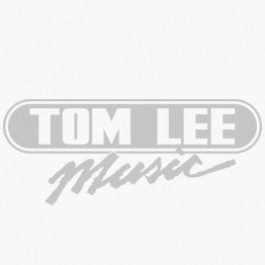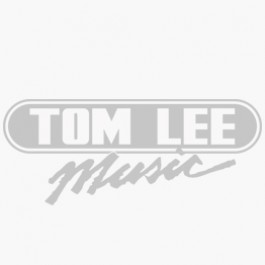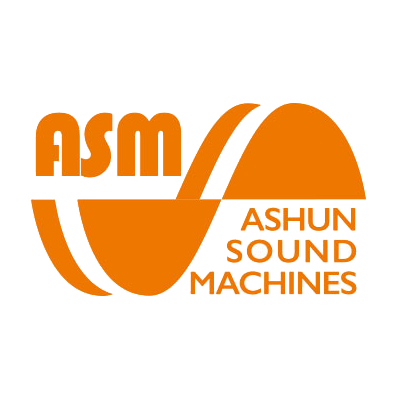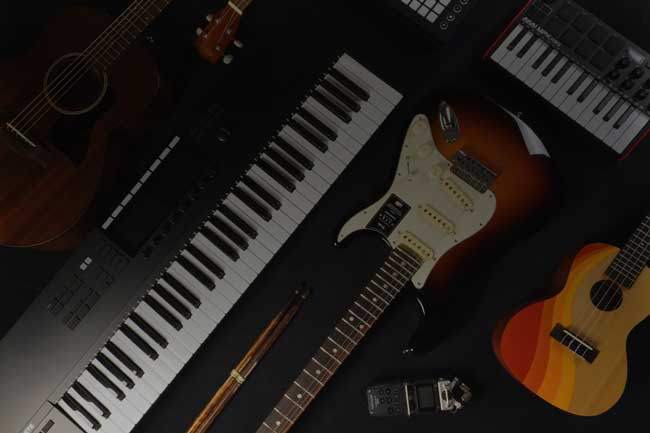- Catalog #: HSMK8E
- 8-VOICE
Hydrasynth Explorer Limited Edition Orange
Portable Digital 8-Voice Wave-Morphing Synthesizer Keyboard
Create otherworldly sounds on the go with the limited-edition orange ASM Hydrasynth Explorer, an 8-voice wave-morphing synthesizer with a 37-note midsized keyboard featuring a Polytouch keybed that provides an unprecedented amount of control and expression. The Hydrasynth Explorer can be powered by the included power supply or via eight AA batteries (not included).
The Hydrasynth Explorer builds upon the success of the original Hydrasynth, featuring an easy-to-use interface with minimal paging and workflow shortcuts. The proprietary ASM polytouch keybed provides the usual velocity-sensitivity and aftertouch, but also supports full polyphonic aftertouch.
The Hydrasynth Explorer's sound engine features three oscillators per voice with dual Wave Mutators, two series or parallel multimode filters, five LFOs, five looping envelope generators (DAHDSR), a 32-slot modulation matrix, advanced arpeggiator, comprehensive CV/gate, MIDI, and USB MIDI I/O, and dedicated pre- and post-FX plus reverb and delay. The effects chain goes beyond the typical ones found in other synths. Pre-effects and post-effects give you some unique ways to process your sound; the delays and reverbs were modeled on some of the most popular effects on the market. The Hydrasynth ships with a power supply.
Firmware 2.0
- Expanded memory to 8 banks for a total of 1024 patches
- New modulation source: VOICE MODULATOR allows you to offset values for each voice that can then be applied in the Mod Matrix to vary chosen parameters per voice
- OSC Bit Reducer: Osc 1, 2, and 3 have a choice of Off, 16, 12, 10, 9, 8, 7, 6, 5, 4, 3, and 2 bits
- LFO and ENV Quantizer: ENV 1 to ENV 5 and LFOs (Low Frequency Oscillators)—LFO 1 to LFO 5 have new Quantize options, so adventurous users like you can quantize the outputs to achieve a unique stepping effect
- LFO Step Advance: Choose to advance through the steps with each new Note On with the LFOs in Step mode; meaning you can play through the steps one by one with each new note press
- Global FX Bypass: Bypass each of the effects (Pre-FX, Post-FX, Delay, and/or Reverb) globally in the system page—to record a dry signal without having to edit each patch
- Increased Vibrato Resolution: Fine control for more subtle options
- New Sustain Pedal Options: Sustain—traditional sustain (as it has always worked), Sostenuto—press and hold a single note while playing notes above it, and Mod Only—disables the sustain function, allowing you to then route it in the Mod Matrix
- More LED Options: Dim, On/Off
- Glissando in glide options
- Arp Range goes to 6 octaves
- Arp Step Offset parameter
- More Rand/Init shortcuts (all STEP LFO steps, Wavescan waves, Voice mod offsets)
- Local On/Off saved
Polytouch Keybed
- The Hydrasynth Explorer features the ASM Polytouch 37-note midsized semiweighted keybed, allowing both on/off velocity and aftertouch, as well as full polyphonic aftertouch.
Portability
- The Hydrasynth Explorer can be powered by its included power supply or by 8 x AA batteries, not included.
- The expected life for battery operation is around 3 to 4 hours depending on type, make, and model.
Oscillators
- The oscillators allow you to choose from a selection of 219 single-cycle waveforms.
- Wavemorphing is a feature usually found on synths with preset wavetables. Creating user wavetables is arduous or downright impossible. Unlike most wavetable synths, oscillators 1 and 2 have a Wavelist mode that allows you to pick and choose 8 waves from a bank of 219, arrange them in the order you want, and then morph from one to another.
Mutators
- Oscillators 1 and 2 are routed into the Mutators. The Mutators allow you to modulate, bend, and sculpt the sound in new (and old) ways.
- The Wave Mutants can also generate their own waveforms in both FM and Sync modes, so you do not have use another oscillator. The routing is flexible, so you can choose the other oscillators as mod sources if you like.
- Each Mutant allows you to choose from the following processes.
- FM-Linear for making classic FM sounds. Choose multiple FM sources, including external inputs.
- Wavestack creates 5 copies of the incoming sound and allows you to set a detune amount.
- Hard Sync gives you those classic hard sync sounds. Try hard syncing a morphing wavetable for some fun.
- Pulse Width will pulse width modulate any input sound.
- PW-Squeeze is a different form of pulse width mod that creates a smoother sound.
- PW-ASM mode divides the incoming wave into 8 slices and allows you to set how much pulse width mod will happen in each section.
- Harmonic Sweep will sweep the harmonics of the incoming sound.
- PhazDiff takes the input signal, shifts the phase, and then creates a difference result with the original signal.
Mixer/Filter Routing
- The Oscillators are fed into a mixer along with the Noise generator and Ring Modulator.
- The Mixer allows you to mix levels and pan the input source.
- There is a balance control that allows you to choose how much signal of each source is routed to filters 1 and 2.
- The filters can be set to be in parallel or in series, for ultimate flexibility.
Filters
- The first filter has 16 different filter models, giving you multiple options for tailoring your sound.
- The second filter is a 12 dB per octave slope filter and has a continuous sweep from either low pass, to bandpass, to high pass, or low pass, to notch, to high pass—similar to the way the classic SEM filters work.
LFOs
- 5 low-frequency oscillators.
- Much like the sound engine, the LFOs are not ordinary by any means.
- The Hydrasynth LFOs feature a Step mode that allows you to create patterns with up to 64 steps. Having 5 mini step sequencers gives you an amazing amount of possibilities for further shaping your sound.
- There are 10 standard waveforms from which to choose.
- The LFOs all have delay, fade in, 3 triggering modes, smoothing, start phase, and one-shot mode, so that they can act as envelopes and BPM sync.
Envelopes
- 5 DAHDSR Envelopes.
- An advanced sound engine needs plenty of modulation sources. The 6-stage envelopes feature Delay, Attack, Hold, Decay, Sustain, and Release stages.
- The time settings for the stage can be set in seconds or in time divisions, giving you envelopes that play in sync to your song.
- You can also loop the envelopes to create LFOs whose shape can be voltage controlled in the modulation matrix.
- The envelopes have the added ability to be triggered from multiple sources.
Modulation Matrix
- The modulation capabilities on the Hydrasynth are endless.
- With 32 user definable modulation routings, you will have plenty of ways to use the 29 modulation sources and 155 modulation destinations.
- Almost everything in the synth engine can be a modulation destination including the effects and arpeggiator.
- The Modulation matrix points themselves can also become modulation destinations.
- Modulation sources and destinations include the CV Mod in and out jacks as well as MIDI CCs
Arpeggiator
- The arpeggiator allows for standard note arpeggiations but also has a phrase arpeggio built-in. Parameters like Ratchet and Chance will generate other rhythmic patterns with some randomness to add life and spontaneity to your performance.
- You can also modulate most of the parameters in the arpeggiator—so, imagine using LFOs, Envelopes, Polyphonic Aftertouch, or the ribbon controller to modify your arpeggios in real time.
CV/Gate, MIDI, USB
- There is the standard MIDI and USB/MIDI interfaces on the synth and also CV/gate interfaces for connecting to the modular world
- CV/gate supports the standard voltages for Eurorack modulars, the 1.2V per octave Buchla standard, and some of the Japanese volts/hertz products.
Main Controls
- The Main system controls are where you navigate your patches, configure system settings, and see parameters for the envelopes, waveforms, filters in the OLED screen.
- Init and Random buttons will allow you to initialize or randomize a complete patch or specific modules with a press and hold + module select button.
- Pressing the Home button returns you to navigating patches in a simple and easy way.
Master Control
- The Master Control section is where all parameter editing, patch naming, and Macro performing is done.
- OLED screens, high-resolution encoders with LED rings, and 8 buttons, for control and visual feedback.
- The Voice parameters give you access to play modes, microtuning, analog feel, voice panning, and more.
Macros
- The patch macros are designed to provide deep control over the engine in live performance.
- The 8 assignable encoders and buttons can each be routed to 8 destinations. Complete sound transformations can take place with the press of a button or turn of a knob.
Patches
- The Hydrasynth Explorer comes with 5 banks of 128 patches.
- Finding the patch you want and searching the library is made easy with the browser. The PC-/Mac-based Patch Manager application allows you to easily move patches and create your favorite order, as well as load in new patch libraries in the future.
Effects
- The effects chain goes beyond the typical ones found in other synths. Pre-effects and post-effects give you some unique ways to process your sound.
- The delays and reverbs were modeled on some of the most popular effects on the market.
- The effects are the perfect way to complete your sound.
Specifications
- Sound Generation
- Analog
- Keyboard
- 37 Mid-Size Keys with Semi-Weighted Action
- Touch Sensitivity
- Yes
- Aftertouch
- Yes
- Expression Controls
- 1x Pitch Bend
- 1x Modulation
- Displays
- LCD
- Number of Sounds, Kits, or Samples
- 1024x Factory Sound Preset
- Favorites Recall
- 32x Quick Recall Slot
- Maximum Polyphony
- 8 Voice (Poly-Chaining Capable with Multiple Units)
- Built-In Effects
- 9x Preset (Factory) Chorus, Compressor with Sidechain, Delay, Distortion, Flanger, Phaser, Reverb, Rotary, Tremolo
- 6x Reverb
- 5x Delay
- Performance Functions
- Arpeggiator, Octave Shift
- Oscillators
- 2x Variable
- 1x Fixed
- Mixer
- Oscillator, Oscillator 2, Oscillator 3, Noise, Ring Modulation
- Envelopes
- 5x Envelope Generator: Delay, Attack, Hold, Decay, Sustain, Release
- Filters
- Number of Filters: 2
- Characteristic: Ladder (Classic)/Ladder (Modern)
- Type: Low-Pass, Band-Pass, High-Pass
- LFOs
- Number of LFOs: 5x Polyphonic
- Waveforms: Sine, Sawtooth Up, Sawtooth Down, Square, Triangle, Random, Sample & Hold, Noise, Pulse Width 25%, Pulse Width 12.5%
- LFO Rate: 0.02 to 150 Hz
- Controls/Modes: One-Shot
- Modulation Matrix
- 32-Slot (35 Sources / 191 Destinations)
- Arpeggiator
- Range: Up to 6 Octaves
- Modes: Up, Down, Up & Down, Random, Chord Mode
- Features: Octave Shift, Swing Setting(s)
- Supported MIDI Standards
- GM
- Audio I/O
- 2x 1/4" TS Main Output
- 1x 1/4" Stereo Headphone Output
- Pedal Support
- 1x 1/4" Sostenuto/Sustain (Pedal Not Included)
- MIDI I/O
- 1x DIN 5-Pin Input
- 1x DIN 5-Pin Output
- CV/Gate I/O
- 5x 1/8" / 3.5 mm CV/Gate Output
- USB I/O
- 1x USB-B (MIDI)
- OS Compatibility
- Windows / macOS
- Required Hardware
- USB-A Port
- Power Requirements
- AC/DC Power Adapter, Battery
- Battery Type
- 8x AA
- Color
- Orange
- Dimensions
- 21.9 x 10 x 3.1" / 55.6 x 25.5 x 7.8 cm
- Weight
- 7.5 lb / 3.4 kg





